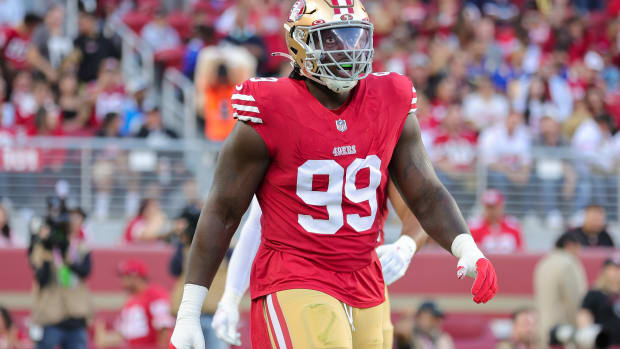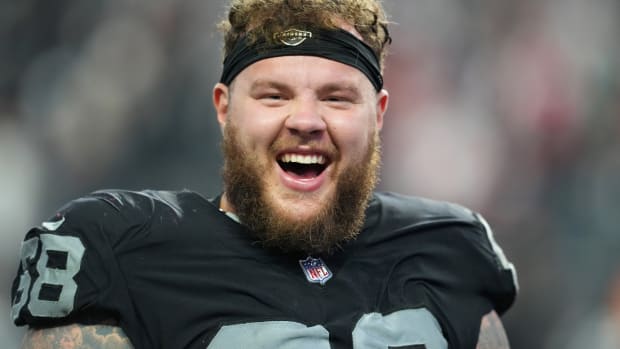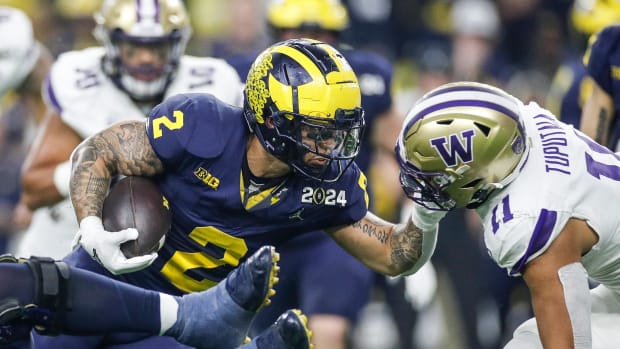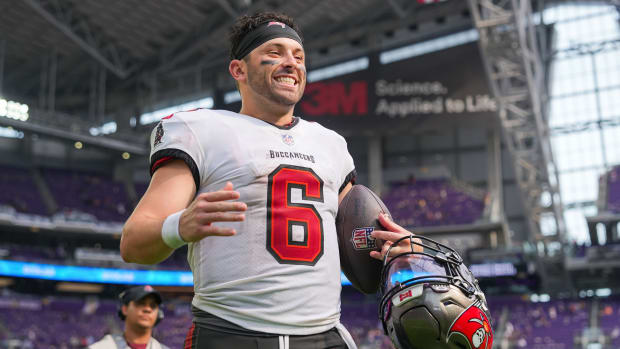Speed of a Zebra
Speed of a Zebra
As head linesman, Turner watched for offside and coverage men leaving too early, then slid downfield to look for illegal blocks.
But once the runback was on, he his job was to stay as close to the action as possible.
Here, that meant shifting direction to match Sproles, while keeping his eyes on the runner . . .
. . . as well as on blocker Chris Polk and punter Andy Lee.
At this point Sproles had been at top speed for nearly 30 yards . . .
. . . but Turner, too, hit his stride . . .
. . . and got in step with the returner inside the Niners’ 20.
Once Lee was out of the play it was clear Sproles would score.
The linesman’s responsibility is the end zone, so Turner must accompany the runner to goal line.
Sproles clocked a 4.47 40 at the combine and doesn’t appear to have lost a step.
But Turner doesn’t do too shabby here either . . .
. . . staying mostly stride for stride with the speedy Sproles to the 10-yard line . . .
. . . whereupon Sproles cruises to the end zone and Turner begins to pull up to get in position to signal the TD.
It’s congratulations for Sproles, and some pretty impressive work for first-year NFL official Turner.
PHOTOS BY JED JACOBSOHN FOR SI/THE MMQB
NFL linesmen don’t have to sprint very often—but when the time comes, they'd better be ready. First-year official Patrick Turner passed his conditioning test during Darren Sproles’ 82-yard punt return in the second quarter of Sunday’s 49ers-Eagles game, nearly matching Sproles stride for stride on the last leg to the end zone.
To fully appreciate Turner’s burst, rewind to the beginning of the play. Turner has several responsibilities on punts. First: ensure everyone is onside. Then make sure none of the ineligible players sneak downfield before the ball is kicked. After that Turner’s responsibility is to move downfield toward the runback and watch for potential holding penalties.
“Then comes the uh-oh moment,” says Mike Pereira, the former president of NFL officiating and now a FOX analyst. “If it looks like the receiver is going in for a touchdown, Turner, the linesman, is responsible for the end zone.”
That means shifting direction and heading downfield, as close to the runner as possible. Ideally the linesman should beat the player to the goal line. “It’s really difficult because you’re going toward him when he catches the ball, then you have to reverse direction, and it’s a sprint. One of the few sprints that linesmen have—but it’s a dead-on sprint.” What’s more, the linesman’s head has to be turned toward the play to look for illegal blocks and other infractions, while the return man is running full-out (and maybe watching himself on the JumboTron).
• ON FURTHER REVIEW: Get to know New York’s newest star
Turner picked up Sproles—a noted speedster who has been clocked at 4.47 in the 40—inside the 30 and matched strides with him before losing a step around the 8. The official pulled up over the final five yards to make the touchdown signal while Sproles continued through the end zone. Turner has been officiating since 1986 according to an online bio (officials typically are not permitted to talk to the media during the season), and his experience clearly played into his faultless positioning.
As did, no doubt, his physical conditioning. For NFL officials, Pereira says, that element is nearly as important as mastery of the rules. “Perception is a big part of it,” Pereira says. “If you don’t look like you can run and keep up with the players, then your credibility is called into question.” He says he’d be surprised if 90 percent of officials didn’t hit the gym at least five days a week. That’s especially crucial for someone like Turner, who moved up to the NFL this year from officiating Pac-12 games. “The NFL is so much faster you can’t believe it,” Pereira says. “In college, you have one or two guys who are really fast. In the NFL it’s everyone. Even linemen who are 325 pounds are fast. And not only is it the physical speed of a player running, but the speed of the game. For someone like Patrick Turner, a well-respected official in the Pac-12, it will take five years to get up to speed.”
The learning curve—another area where players and officials are stride-for-stride.


















































